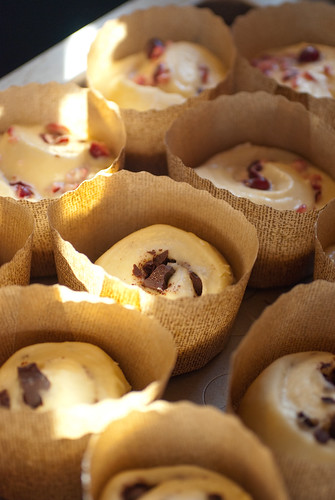Which brings me to brioche. Oh, brioche. So delicate and rich. Something you buy at a fancy bakery but wouldn't dare to make at home. All this talk about yeast and sponge - it's too... mysterious. Too scary! This is my advice to you: Go forth fearlessly! Trust me, baked goods can smell fear. Take a deep breath and just read the instructions. Take your time. The worst that can happen is that you learn from your mistakes. And is that really so bad?
I don't see anything scary about those tender lumplings!
This brioche is delicious and buttery, but has a nice light and delicate crumb. It is time consuming but well worth it. I chose to make 2 different varieties by rolling the dough out into a sheet and filling & rolling it much like you would cinnamon rolls (this would be an awesome dough for exactly that purpose!) The chocolate is simply chopped bittersweet chocolate, and the cranberry cream cheese is a mixture of about 1/2 a cup of chopped cranberries, 4 oz of cream cheese, a couple tablespoons of brown sugar and some orange zest. Or you could just make a whole loaf. Make some french toast! Mmmmm...
Basic Brioche
adapted from The Bread Bible by Rose Levy Beranbaum
For the best flavor, the sponge can be allowed to ferment in the refrigerator for a day prior to making the dough, but it is not necessary. The dough, however, should be made 1-2 days ahead.
Starter (Sponge):
2 tablespoons water, at room temperature (1 ounce or 29.5 grams)
1 tablespoon sugar (scant 0.5 ounce or 12.5 grams)
1/4 teaspoon instant yeast (0.8 grams)
1/2 cup all-purpose flour (2.5 ounces or 71 grams)
1 large egg (2 ounces or 58 grams weighed in the shell)
Flour mixture:
1 cup plus 1 1/2 tablespoons all-purpose flour (5.5 ounces or 156 grams)
2 tablespoons sugar (about 0.75 ounce or 25 grams)
1 1/4 teaspoons instant yeast (4 grams)
1/2 teaspoon salt (3.3 grams)
2 large eggs, cold (4 ounces or 113 grams weighed in shells)
8 tablespoons very soft unsalted butter (4 ounces or 113 grams)
Egg Glaze (if making a large loaf, glaze is optional)
1 large egg yolk
1 teaspoon milk or cream
1. For the Starter: In the mixer bowl, place the water, sugar, instant yeast, flour, and egg. Whisk by hand until very smooth, to incorporate air, about 3 minutes. The sponge will be the consistency of a very thick batter. (At first the dough may collect inside the whisk, but just shake it out and keep whisking. If it’s too thick to whisk, it means you’ve added too much flour and will need to add a little of the eggs to be added in Step 3.) Scrape down the sides of the bowl and set it aside, covered with plastic wrap and allow to sit for at least 1 hour, or refrigerated for up to 24 hours.
2. For the flour mixture: In a small bowl, whisk the flour with the sugar and yeast. Next, whisk in the salt. Sprinkle this mixture on top of the sponge. Cover it tightly with plastic wrap and let it stand for 1 1/2 to 2 hours at room temperature. (During this time, the sponge will bubble through the flour mixture in places; this is fine.)
3. For the Dough: Add the 2 cold eggs and mix with the dough hook on low for about 1 minute or until the flour is moistened. Raise the speed to medium and beat for 2 minutes. Scrape the sides of the bowl with an oiled spatula and continue beating for about 5 minutes longer or until the dough is smooth and shiny but very soft and sticky. It will mass around the dough hook but not pull away from the bowl completely.
Add the butter by the tablespoon, waiting until each addition is almost completely absorbed before adding the next tablespoon, beating until all the butter is incorporated. The dough will be very soft and elastic and will stick to your fingers unmercifully, but don’t be tempted to add more flour at this point; it will firm considerably after chilling
4. Using an oiled spatula or dough scraper, scrape the dough into a large bowl, greased lightly with cooking spray or oil. Lightly spray or oil the top of the dough and cover with plastic wrap. Allow the dough to rise until doubled, 1 1/2 to 2 hours.
5. After rising, refrigerate the dough for 1 hour to firm it; this will prevent the butter from separating.
6. Gently deflate the dough by stirring it with a rubber scraper or spatula, and return it to the refrigerator for 1 more hour so that it will be less sticky and easier to handle.
7. Deflate the dough and allow it to rest in the fridge for a few minutes. Turn the dough out onto a well-floured surface and press or roll it into a rectangle, flouring the surface and dough as needed to keep it from sticking. The exact size of the rectangle is not important. Give the dough a business letter turn, brushing off any excess flour, and again press down or roll it out into a rectangle. Rotate it 90 degrees so that the closed side is facing to your left. Give it a second business letter turn and round the corners. Dust it lightly on all sides with flour. Wrap it loosely but securely in plastic wrap and then place it in a large zip-seal bag. Refrigerate for at least 6 hours or up to 2 days to allow the dough to ripen (develop flavor) and firm.
8. Remove the dough from the refrigerator and gently press it down to deflate it. You can be creative with how you choose to shape it! Make a loaf, small rolls, cinnamon buns, etc. For various baking times please see the link to the original recipe.
If you are making rolls like mine with fillings, roll the dough out into a large rectangle. Sprinkle or spread your fillings onto the rectangle leaving about an inch of space at the top of a long side. Roll the dough up and pinch it closed. Cut the dough into 16 pieces by cutting it in half and cutting each half in half until you have 16 pieces. Place into an oiled muffin/brioche pan or baking cups and cover loosely with oiled plastic wrap and allow to rise for about an hour.
9. Preheat the oven to 425°F 1 hour before baking. Have an oven shelf at the lower level and place a baking stone or baking sheet on it before preheating.
10. Lightly beat together the egg yolk and cream for the glaze. Brush the top of the brioche with the egg glaze, being careful not to drip any on the side of the pans, or it will impede rising. Allow it to dry for 5 minutes and then brush a second time with the glaze.
11. Set the rolls on the hot stone or hot baking sheet. Bake for 10 to 15 minutes, or until a toothpick comes out clean.
12. Remove the brioche from the oven and unmold them onto a wire rack (if you are using paper baking molds just allow them to cool as they are)


gorgeous, been meaning to try brioche, think you've given me a reason now!
ReplyDelete